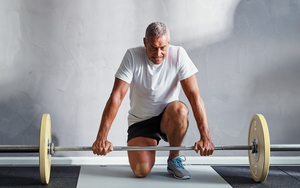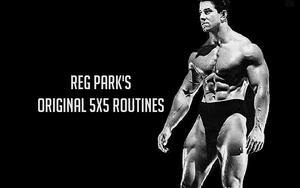
How to Master The Snatch Grip Deadlift
The "snatch grip" deadlift variation has exceptional carry-over benefits for athletes and weekend warriors alike. Learn how to make this a staple in your training.
It gets its name because a wide grip, the same as used in the Olympic lift, the snatch, is used. Because of the wider grip, you are going to get a much greater range of motion.
Often, Olympic lifters will use the snatch grip deadlift as an assistance movement for the snatch.
The wide grip also causes you to start much lower to the ground with more knee and hip flexion as well as recruit more of the upper back muscles - the lats and traps, rear deltoids and rhomboids.
The snatch grip deadlift also has massive benefits for grip strength as well. In all the muscles worked include the spinal erectors, lats, traps, glutes, quadriceps, hamstrings and forearms

How to Perform the Snatch Grip Deadlift
- Standing with feet shoulder width apart with the feel turned at a slight outward angle, placing the middle of your shoelaces under the bar.
- Place a wide double overhand grip on the bar with your index fingers over the outermost lathe mark on the bar.
- After setting your hips back and down, start to tension your upper back muscles down by pulling your shoulder blades back and downwards.
- Position your shoulders over and slightly ahead of the bar.
- Hips should be slightly higher than the knees with the knees themselves being more flexed than what they would be with a conventional deadlift due to the wide grip.
- Then begin to tension the bar by pulling the slack out of the bar by pulling with the upper back while pushing your heels into the floor.
- Then dropping your hips, feel as if you are pushing the floor away with your legs while continuing to pull with the back, keeping the chest pulled back high, straightening your legs and keeping the weight as close to your body as possible, just as you would with a regular deadlift.
- The grip width that is ideal for you should have the bar at level with being in between the pubic bone and slightly below the anterior superior iliac spine (the so-called "hip bones"). In other words just over the lower abdomen or "hip crease".
- Lower the bar by reversing the way you lifted it, back down to the ground while maintaining the same tension in your upper back and hips.
Snatch Grip Deadlift Variations
There are some specialized variations of the snatch grip deadlift to improve your performance on any of the nuances of the lift, such as increasing power off of the floor, lockouts or as hypertrophy movements.
No Touch Snatch Grip Deadlifts
The idea here is to lower the bar but not actually let it touch the floor, maintaining constant tension throughout each concentric and eccentric rep. This is a brutal way of increasing time under load and stimulating muscle growth. Needless to say, one should lower the weight a bit to accommodate for the additional stress.
Snatch Grip Deadlifts From a Deficit
One way to work on generating power off of the floor is by standing on a block several inches high, typically 4" or so. Doing deadlifts from a deficit position primarily offers massive benefits for increasing your overall range of motion.
The force that a deficit snatch grip deadlift generates also increases the stress on the overall posterior chain and hamstrings, which is where your strength gains will come from making you stronger, as well as more explosive off the floor.
It was also one of the late Charles Poliquin's favorite movements for building lower body strength in athletes, particularly when done from the deficit of a 4" podium. He was also a big believer in this exercise because it is among the best for putting on mass, fast.
Snatch Grip Deadlifts With Varying Resistance
Another useful variant is using chains or bands at the ends of the bar to increase the force accumulation and motor unit/muscle fiber recruitment.
Mistakes Performing the Snatch Grip Deadlift
Hips/posterior rise too quickly. Many will make this mistake, allowing too much force to be put on the lumbar spine.
Bar not staying as close to the body as possible. Again, if this is the case, this too will increase the shearing forces on the lumber spine excessively.
Outer fingers coming off of the bar. If this happens, it is best to experiment with your grip. Your perfect grip width can be determined by grabbing an empty bar so that when you are fully upright, it sits just below the hip crease or "hip bones".
If you are doing grappling or MMA, or any sort of wrestling, which relies on shooting in for doubles, you'll see its benefits the first time you try it!
Snatch Grip Deadlift Sample Routine
Let's look at several ways of integrating this movement into a productive exercise routine. We will look at making it part of an upper/lower and push/pull split.
Upper/Lower Split
Workout One: Lower
Snatch Grip Deadlift 4 sets x 8-10
Barbell Rear Foot Elevated Split Squat 4 sets x 8-12 reps
Glute-Ham Raise or Reverse Hyperextensions 3-4 sets x 10 reps
Standing Calf Raise 3 sets x 12 reps
Workout One: Upper
Incline Barbell Press 4 sets x 8-10 reps
Weighted Chin-Ups 4 sets x 6-8 reps
One-Arm Dumbbell Rows 4 sets x 8-10 reps
Weighted Dips 4 sets x 10-12 reps
Push/Pull Split
Workout One: Pull
Snatch Grip Deadlift 4 sets x 8-10
T-Bar Row 4 sets x 8-10 reps
Seated One-Arm Cable Rows 4 sets x 10 reps
Hammer Curls 3 sets x 10 reps
Leg Curls 3 sets x 12 reps
Workout One: Push
Close Grip Bench Press 4 sets x 8-10 reps
Leg Press 4 sets x 10-12 reps
Seated Dumbbell Press 4 sets x 8-10 reps
Seated Overhead Single Dumbbell Triceps Extensions 3 sets x 10-12 reps
Standing Calf Raise 3 sets x 12-15 reps





